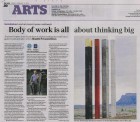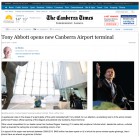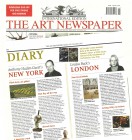
Installation Land art project spans continents
Body of work is all about thinking big
Andrew Rogers is an Australian Sculptor making his mark on a grand scale globally, writes Bhakthi Puvanenthiran.
While Andrew Rogers may not be particularly well known in his home town of Melbourne, the sculptor and land artist has made his mark on every continent – even Antarctica.
Rogers’ work has been commissioned by the likes of former Mexican president Vincente Fox, former prime minister John Howard and the United Nations. All this without going to art school.
“I didn’t have the opportunity to go to one, but art schools are terribly important. They give you a chance to have good teachers,” Rogers says.
Rogers was exposed to one good teacher, studying under the legendary Melbourne painter John Brack for two years while at high school.
“He was demanding, he was disciplined, he made you focus and he made you work hard, but it’s all for those reasons that you learn to draw and you learn to paint and you learn to perceive.”
After high school, Rogers travelled overseas, visiting galleries around the world and eventually making his own attempt at creating art.
“The first thing I went and did was get some soapstone, which anyone can do, and carve my left hand with my right hand, sitting at my desk. Gradually I thought if I can do my hand, then I can do a body. I thought if I can do a body, a form with so many planes and angles, and then I could, finally, abstract the movement.”
Rogers’ Rhythms of Life land art project spans Antarctica, Mexico, Turkey and various locations in Asia, while a work from the current series, entitled I am, was commissioned for the UN’s Dag Hammarskjöld Plaza in New York.
His latest works are a series of delicately balanced forms, unfurling from a narrow base and reaching up to 7.5 metres high. They are a metaphor for the relationship with the organic, the sanctity of the individual and the relationship between the inner and outer world.
It’s hard not to see the religious in Rogers’ work, thought he shies away from specifics when pressed on the matter.
“The values derived from the morals and ethics of religion are a definite influence on thoughts behind some elements of my practice,” he says.
Rogers’ works often involve kilometres of land, tonnes of material and hundreds of workers.
One such project in Kenya employed 1270 Masai most of whom were traditional nomads, pastoralists and herders who had never earned wages. The research and detailed planning that goes into a project of this scale would daunt most people, but Rogers seems to enjoy it.
“Whenever I do land art, I never disturb natural flora, so I had to find somewhere arid. Then we had to find somewhere with lots of rocks, so it needed a volcanic activity. We looked at many maps and talked to lots of people until we found the right site.
“I believe that history and heritage are very important, so when I go to a society I ask…the elders what’s important for them, what do they want to preserve. I never impose anything and I try and let them select from what they feel is important.”
While sensitive to culture, ultimately Rogers is captivated by the universal: a fact reflected in his love of geometry.
“The same maths is behind the Taj Mahal, is behind the UN building, is behind the Acropolis, is behind some of Gaudi’s forms and it’s the same maths that I use as well” he says.
His current series had an early iteration in the foyer of Canberra Airport, a form that weighs a massive 4.5 tonnes with a base diameter of only 25 centimetres. To get these kinds of number to work, Rogers must do the hard yards as an amateur engineer. In recent weeks he has installed sculptures from the series in Tahiti, Hawaii and Montreal.
Rogers is a man pleased with the results of his labour-intensive work.
“In New York, kindergarten students play amongst my sculptures in front of the UN building, which is just as it should be. I love to see people climbing on my sculptures, touching them, stopping and taking photographs.”
21 February 2014
Also online: http://www.theage.com.au/entertainment/art-and-design/australian-sculptor-andrew-rogers-earns-global-fame-with-monumental-installations-20140220-3342n.html


